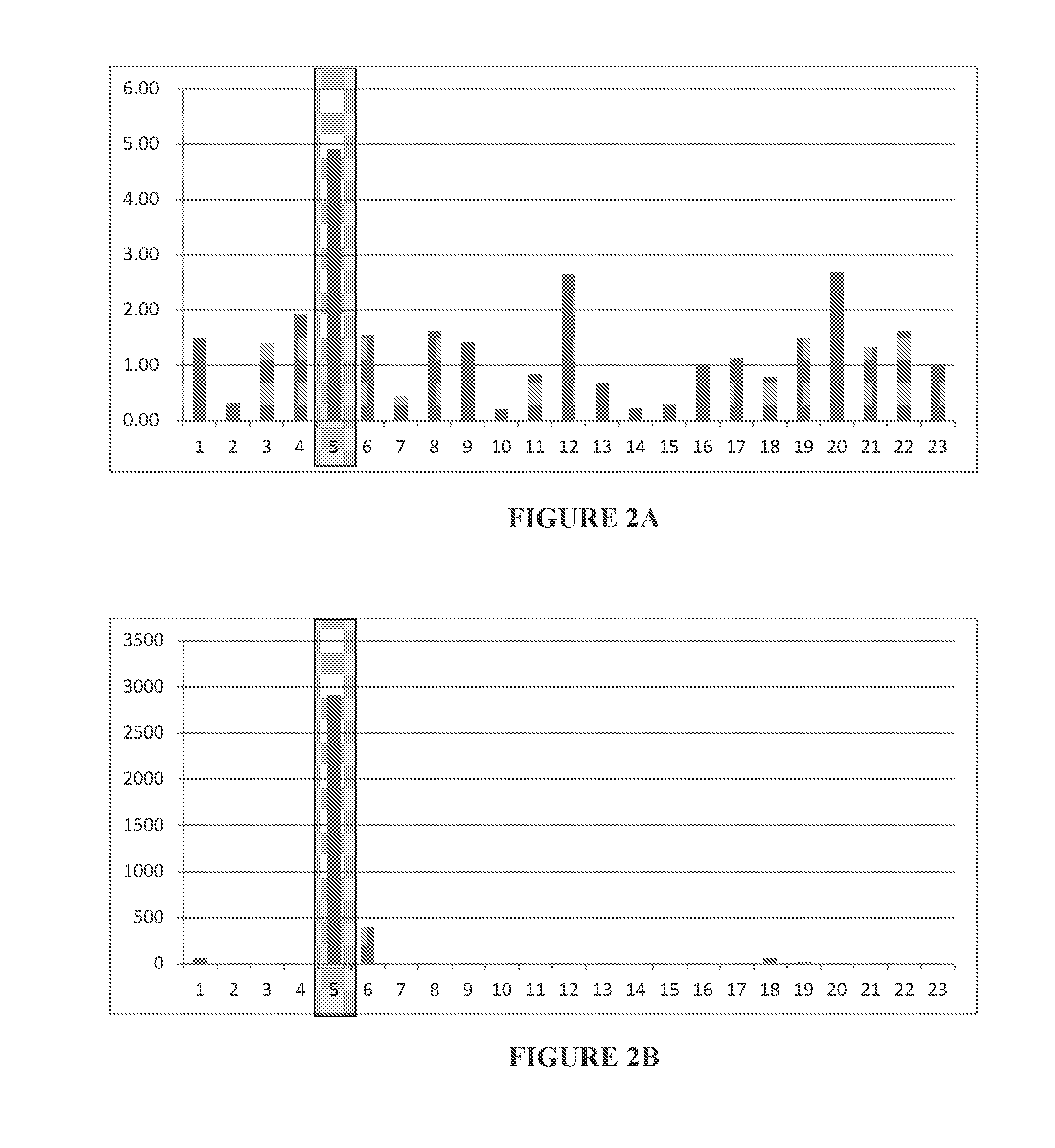Methods for determining drug efficacy for treatment of cancer using ratios of cereblon associated proteins
- Summary
- Abstract
- Description
- Claims
- Application Information
AI Technical Summary
Benefits of technology
Problems solved by technology
Method used
Image
Examples
example 1
6.1 Example 1
Preparation of 3-(4-amino-1-oxo-1,3-dihydro-isoindol-2-yl)-piperidine-2,6-dione (lenalidomide)
Methyl 2-bromomethyl-3-nitrobenzoate
[0428]A stirred mixture of methyl 2-methyl-3-nitrobenzoate (14.0 g, 71.7 mmol) and N-bromosuccinimide (15.3 g, 86.1 mmol) in carbon tetrachloride (200 mL) was heated under gentle reflux for 15 hours while a 100 W bulb situated 2 cm away was shining on the flask. The mixture was filtered, and the solid was washed with methylene chloride (50 mL). The filtrate was washed with water (2×100 mL), brine (100 mL), and dried. The solvent was removed in vacuo and the residue was purified by flash chromatography (hexane / ethyl acetate, 8 / 2) to afford 19 g (96%) of the product as a yellow solid: mp 70.0-71.5° C.; 1H NMR (CDCl3) δ 8.12-8.09 (dd, J=1.3 and 7.8 Hz, 1H), 7.97-7.94 (dd, J=1.3 and 8.2 Hz, 1H), 7.54 (t, J=8.0 Hz, 1H). 5.15 (s, 2H), 4.00 (s, 3H); 13C NMR (CDCl3) δ 165.85, 150.58, 134.68, 132.38, 129.08, 127.80, 53.06, 22.69; HPLC, Water Nove-Pak / ...
example 2
6.2 Example 2
High mRNA Expression Level Ratio of CRBN to IKZF1 or IKZF2 Correlates with Lenalidomide-Responsive ATL Cells
[0434]Twenty-three types of cells from, e.g., ATL cell lines, lymphoma cell lines, leukemia cell lines, healthy peripheral blood mononuclear cells (PBMCs), and human T-lymphotropic virus 1 (HTLV-1) carrier's PBMCs are employed in this example. Among these types of cells, cell line 5 is a lenalidomide-highly-sensitive ATL cell line; cell lines 6 and 12 are lenalidomide-weak / moderate-sensitive ATL cell lines; and other cell lines (cell lines 1-4, 7, 10-11, and 13-23) exhibit intense tolerance to lenalidomide.
[0435]mRNAs of CRBN, IKZF1 (Ikaros), IKZF2 (Helios) and IKZF3 (Aiolos) from each type of cells were extracted and quantitated by qPCR, and the ratio of CRBN mRNA expression level to IKZF1 mRNA expression level, and the ratio of CRBN mRNA expression level to IKZF2 mRNA expression level were calculated. The results are shown in FIG. 2A (CRBN / IKZF1) and FIG. 2B (CR...
example 3
6.3 Example 3
Lenalidomide Exhibits Various Proliferation Inhibitory Effects on Different ATL Cell Lines
[0437]Ten ATL-patient derived cell lines, three HTLV-1 transformed cell lines, five HTLV-1 negative T-cell or monocyte malignant cell lines, and two multiple myeloma cell lines (NCI-H929 as responsive and RPMI-8226 as irresponsive controls) were selected for lenalidomide efficacy study. ATL cell lines Hut102, ED40515, S1T, OATL4, and OATL9, HTLV-1 transformed cell lines MT-2, MT-4, and C8166, PTCL cell line Hut78, other T-cell Jurkat, MOLT4, HL60, and monocyte cell line K562 are laboratory stocks (Dr. Hidekatsu Iha, Oita University, and Prof. Kazuhiro Morishita, The University of Miyazaki). ATL cell lines ST1, KOB, KK1, and SO4 are gift from Dr. Hiroo Hasegawa, Nagasaki University). NCI-H929 and RPMI-8226 were purchased from American Type Culture Collection (ATCC: Manassas, Va.). Each cell line was maintained with RPMI-1640 culture media supplemented with 15% fetal bovine serum (FB...
PUM
| Property | Measurement | Unit |
|---|---|---|
| Electrical resistance | aaaaa | aaaaa |
| Ratio | aaaaa | aaaaa |
| Level | aaaaa | aaaaa |
Abstract
Description
Claims
Application Information
 Login to View More
Login to View More - R&D
- Intellectual Property
- Life Sciences
- Materials
- Tech Scout
- Unparalleled Data Quality
- Higher Quality Content
- 60% Fewer Hallucinations
Browse by: Latest US Patents, China's latest patents, Technical Efficacy Thesaurus, Application Domain, Technology Topic, Popular Technical Reports.
© 2025 PatSnap. All rights reserved.Legal|Privacy policy|Modern Slavery Act Transparency Statement|Sitemap|About US| Contact US: help@patsnap.com



